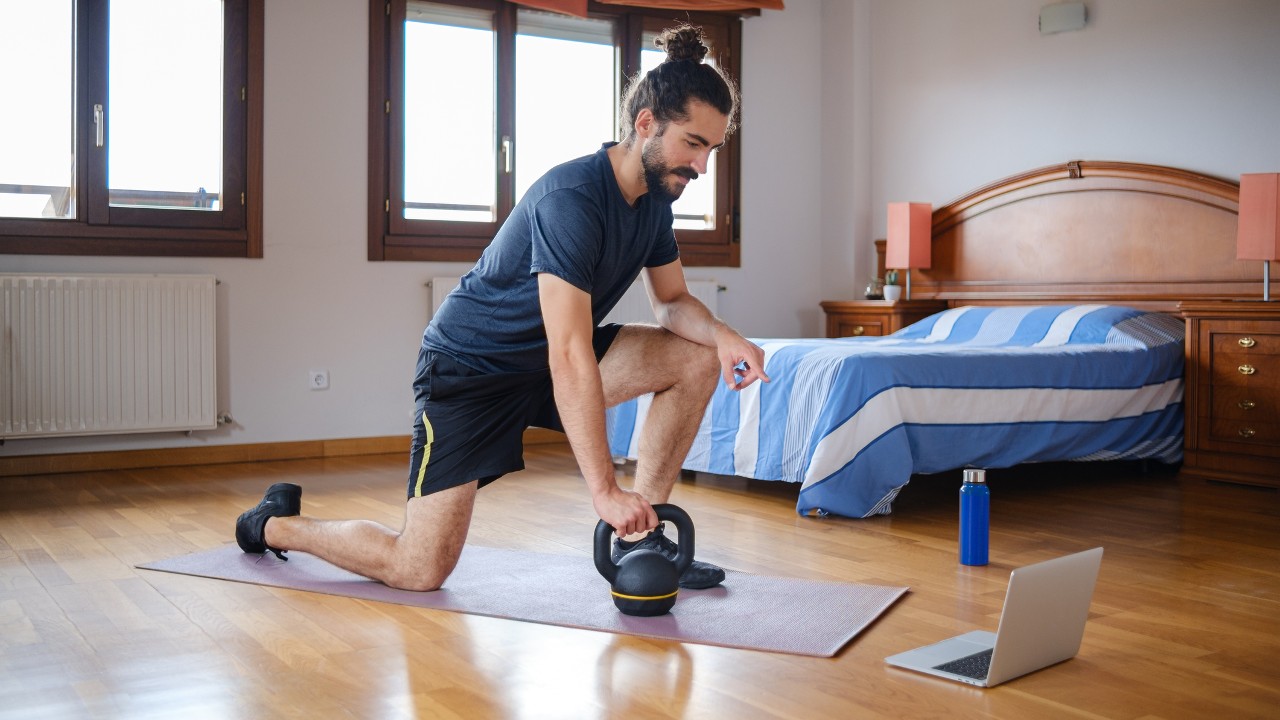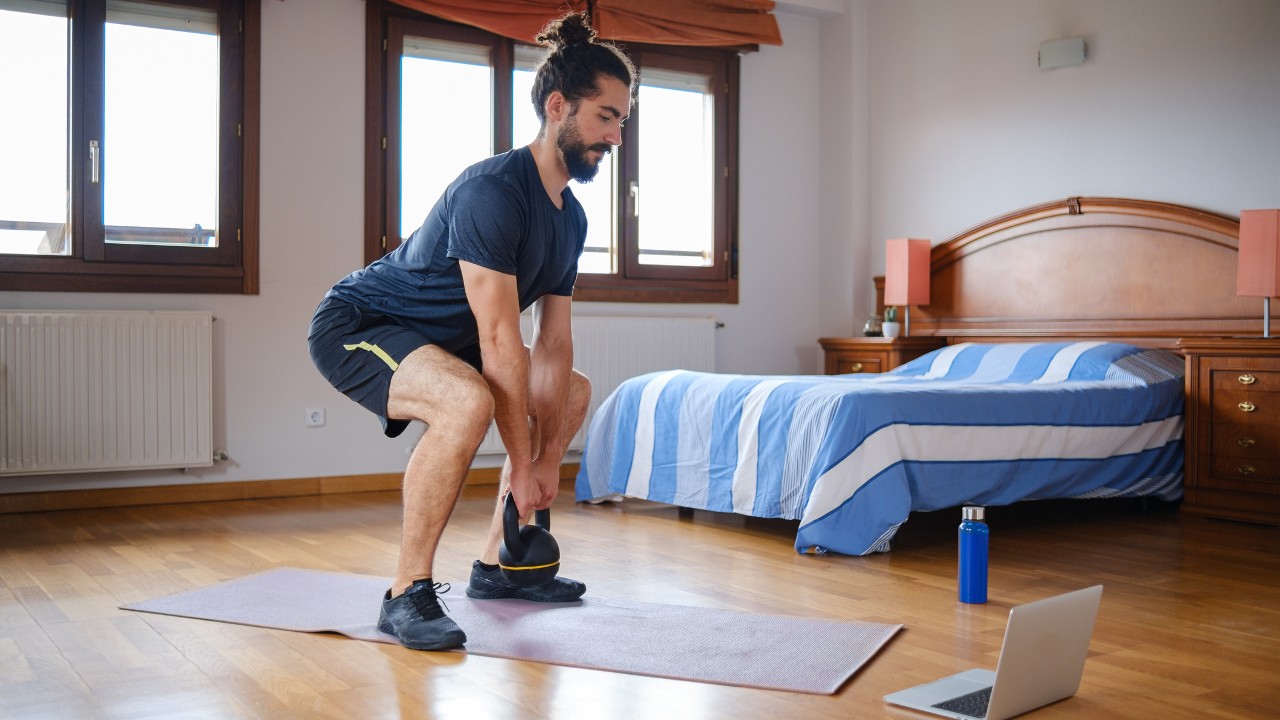
Whatever your level of fitness, the kettlebell is an essential piece of kit to acquaint yourself with. Kettlebell workouts challenge the body to move athletically to help build your functional fitness, improving your strength and power, and they’re great to use for HIIT workouts that boost your cardio fitness too (this kettlebell HIIT workout is a great example).
This kettlebell workout for beginners is designed to be done by anyone and it teaches you four of the best kettlebell exercises. Once you’ve learned them, the moves are great additions to any full-body workout you do.
The beginner’s kettlebell workout has been created by Katrin Schlee, a Gympass personal trainer and expert kettlebell tutor. Try it at the gym, or choose from our selection of the best kettlebells and train at home.
Kettlebell Workout For Beginners
This beginner kettlebell workout is made up of four fundamental kettlebell exercises. “It alternates between ‘grinding’ lifts – the deadlift and goblet squat – and ‘ballistic’ movements – push press and swing – which will target all the major muscle groups,” says Schlee.
Perform all four exercises for 30 seconds each to complete one full circuit. Rest for 60 seconds, then repeat the circuit. “As you become stronger and more proficient with each exercise, try increasing the time you work for to 45 seconds each and/or the number of rounds from two to three or four,” says Schlee.
“Kettlebell training is explosive, but each movement must be performed with the correct technique and full control of the kettlebell,” Schlee adds. “Maintaining a neutral spine and engaging your core muscles along with the target muscles specific to each exercise will help maintain good posture and guard against injury.”
One last point: if you have never worked with kettlebells before, Schlee suggests skipping the kettlebell swing until you’ve had a chance to go through the exercise with a PT so they can ensure your form is correct in person.
Sign up for workout ideas, training advice, reviews of the latest gear and more.
1 Kettlebell deadlift

Time 30sec Rest 0sec
Stand over the kettlebell with your feet shoulder-width apart. Hinge forwards at your hips, keeping your back flat. Your weight should be in your heels. Grab the kettlebell handle in both hands, keeping your arms straight and your chest facing forwards. You should feel your hamstrings load up with tension – these are the primary drivers of the exercise. Drive through your feet to stand, lifting the weight powerfully off the floor. Then slowly reverse the move to lower the weight until it lightly touches the floor, then repeat.
Schlee says: “The deadlift is a great compound lift, working multiple muscle groups and joints simultaneously. Using a kettlebell rather than a barbell means you can keep the weight directly underneath your centre of balance, helping reduce the strain on your lower back.”
2 Kettlebell push press

Time 30sec Rest 0sec
Hold the kettlebell upside down in both hands so the handle is pointing down and you are cradling the bell of the weight in your palms. Alternatively hold the sides of the handle if you find that position more comfortable. Rest the weight against your upper chest. With your feet hip-width apart, bend your knees slightly then drive up powerfully, using the momentum to help press the kettlebell directly overhead. Lean your head back to make sure you don’t catch your chin with the weight. Lower the weight back to your upper chest under control and repeat, breathing in as you lower and exhaling forcefully as you press overhead.
Schlee says: “Explosive lifting like this is about efficiency, not just brute strength. When you dip, ensure your hips don’t shoot back too aggressively as this will cause your chest to cave in. Keep looking straight ahead with your chest facing forwards.”
3 Kettlebell goblet squat

Time 30sec Rest 0sec
Hold the kettlebell the right way up, holding the sides of the handle. Rest the weight against your upper chest but don’t lean back – stand up straight. Engage your core to keep your torso upright. With your feet hip- or shoulder-width apart, bend your knees and hips to sit into a deep squat, keeping your knees wide apart as you lower. Keep your core and lower back muscles engaged to ensure the weight doesn’t pull you forwards. Drive back up to stand, pressing into the floor through your heels. Inhale as you lower and exhale forcefully as you stand.
Schlee says: “All too often personal trainers will cue their clients to push the hips back first, but this will cause you to tip forwards and put pressure on your lower back. Your knees and hips should bend together, simultaneously, allowing you to lower while keeping your torso upright and spine protected.”
4 Russian kettlebell swing

Time 30sec Rest 60sec
Stand with your feet shoulder-width apart and the kettlebell on the floor just in front of you. Bend slightly at the knees and hinge forwards at the hips to grab the handle of the weight. Your shoulders should stay higher than your hips throughout the exercise. Keep your chest and eyes facing forwards, and retract your shoulder blades to engage your mid- and upper-back muscles, then hike the kettlebell off the floor and between your legs to initiate the move. Once your forearms touch your inner thighs, drive your hips forwards to generate power and push your hands away from your body as you stand to swing the kettlebell up until it is level with your eyes. Allow the weight to swing back between your legs and begin the next rep.
Schlee says: “Only attempt this exercise if you feel confident with the technique and always start light. Increase the weight only once you’ve completed a round and feel no adverse effects in your lower back.”

Sam Rider is an experienced freelance journalist, specialising in health, fitness and wellness. For over a decade he's reported on Olympic Games, CrossFit Games and World Cups, and quizzed luminaries of elite sport, nutrition and strength and conditioning. Sam is also a REPS level 3 qualified personal trainer, online coach and founder of Your Daily Fix. Sam is also Coach’s designated reviewer of massage guns and fitness mirrors.
